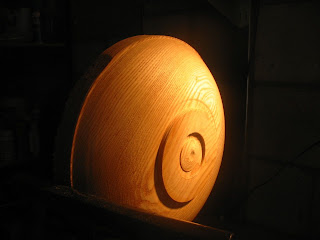I decided to go down to the shop for a couple of hours this morning to continue work on the poplar bowl and begin completing one of the art show pieces. Off to work we go:
Poplar bowl
You'll remember from last time that the surface of the bowl needed more work. Looking at it after the first coat of varnish dried showed that the surface was scratched from sanding and the end grain areas had a lot of pitting and crushed grain fibers. This needed to be corrected before proceeding with the rest of the varnish application so I took it down to the shop and put it back on the lathe.
I began sanding the inside with 120 grit sandpaper and 900 rpm. While the bowl is spinning I drag the sandpaper across the surface of the walls of the bowl very slowly and from the inside of the bowl to the edge of the bowl wall. I don't press hard on the sandpaper either, instead I just let the weight of my hand press down on the paper. The point here is to very gently shave the surface of the wood to remove any crushed grain and reduce the pitting on the surface. I went from 120 - 600 grit paper and this produced a smooth, shiny surface that was ready for another application of varnish:
Here is the bowl after it's been sanded:
And here is the bowl after a coat of varnish. It's hard to see but the surface looks much better:
And while I was doing this I gave the coffee wood bowl another coat of salad bowl varnish too:
Both bowls will require another 1-2 coats of varnish before they're done so stay tuned for more photos. The poplar bowl will be re-mounted on the lathe after I'm done varnishing it so I can clean up the underside of the foot. So it has a little more time in the shop before it's done.
Apple wood box
After looking at the apple wood box, I decided not to turn it any more but to instead sand it and get it ready for finishing and thats what I did. Here is a photo of the lid on the lathe:
The box portion presents a different challenge as the surface is comprised of both solid wood and tree bark. I didn't want to accidently knock off any of the bark so I placed the box on the lathe and locked the lathe in place and hand sanded it. I used 120-400 grit paper on this and I got it really smooth without damaging it:
It's now ready for a finish to be applied. For this I'm going to use a spray lacquer so as to get the finish applied evening to the surface and into all of the nooks and crannies on the bark areas:
Here's the lid after one coat of lacquer:
And here is the box. I'll continue to use spray lacquer for several coats and then I'll take it off the lathe and gently polish the surface by hand:
While the above pieces are making their way through the finishing process, I'll continue working on the art pieces. The next project will be working on the black ash tea box. More about that tomorrow.
VW



















































